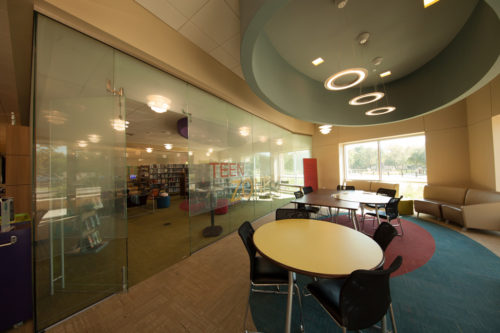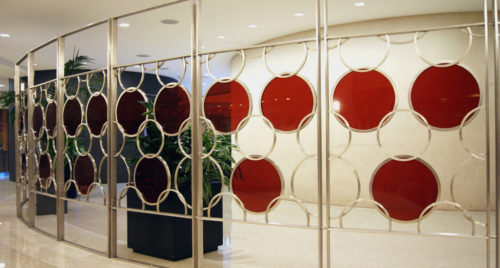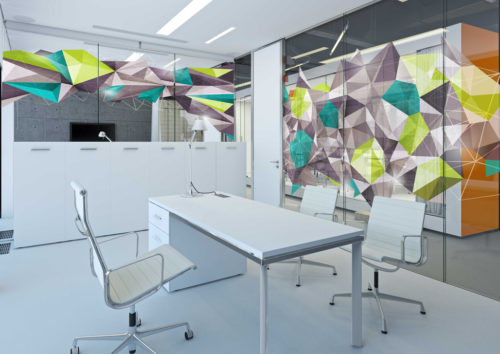3 Ways to Use Glass Panels and Walls
Leave a CommentCreating barriers in commercial and residential settings can be done with style using glass walls and panels. M3 Glass Technologies fabricates custom accent walls and partitions using various unique in-house processes. Our custom glass paneling delivers the function and form your project requires while creating awe-inspiring aesthetics.
Glass wall panels may be used in multiple ways. Here are a few ideas for your commercial or residential environment:
Elevator Interiors
You may think that elevators need not be equipped with aesthetic elements, but they are truly a great area to add some style. Think about their usage—elevators are frequently used by all guests and employees moving throughout your building. Custom glass paneling gives your business the opportunity to add creative touches to the basic functional elements of your facility, where they can be viewed by all. Adding pleasing design elements to your space can help you to promote your brand and present a professional atmosphere to visitors and employees alike.
Using M3’s finishing capabilities, elevator glass paneling can feature elements unique to your brand. Glass wall panels can include your logo, a monochromatic design, or a combination of both.
Room Dividers
To enhance functionality while maintaining consistency in a residential or commercial open-space layout, glass panels may be used as walls to divide the room. Our glass paneling partitions are far more appealing than basic walls, cubicles, or other dividers positioned throughout your office or residential space. They deliver an aesthetic that feels like a work of art rather than a simple divider.
Glass wall panels can be customized to meet a wide variety of styles and needs. Feature your branding and logo throughout your office space, or complement your home’s existing interior style.
Conference & Meeting Rooms
 Conference and meeting rooms are commonly dull while lacking any transparency. This makes it difficult for anyone outside to know who is (or isn’t) in a meeting, and makes it difficult to see if the room is currently occupied. Transparent design glass paneling enhances the functionality of these workspaces. Additionally, glass panels for walls can help you create a modern look in your office.
Conference and meeting rooms are commonly dull while lacking any transparency. This makes it difficult for anyone outside to know who is (or isn’t) in a meeting, and makes it difficult to see if the room is currently occupied. Transparent design glass paneling enhances the functionality of these workspaces. Additionally, glass panels for walls can help you create a modern look in your office.
Some meetings need to remain private, but that doesn’t mean you always have to sacrifice the transparent aesthetic. Our Switchable Glass allows you to switch the glass paneling from transparent to opaque for increased privacy with the touch of a button.
Glass wall panels are very easy to clean. Designers often add glass panels to the walls of a conference or meeting room as a stylish, convenient, and versatile replacement for dry erase boards. Notes can be made with non-permanent marker and easily cleaned before the room’s next use. This is ideal for a wide range of meetings, training, presentations, and more.
Functional Aesthetics from the Design Glass Experts at M3 Glass
Any of the above glass wall panel solutions can be customized to match your branding if desired. Our design and finishing capabilities are numerous—glass paneling can be totally transparent, dark, or anywhere in between.
Download our “Customize Your Space with Design Glass” eBook to learn what other aspects of your commercial or residential space can be enhanced with custom architectural glass!
Why Safety Matters in the Design Glass Process
Leave a CommentIt’s easy to get caught up in the visual appeal of design glass, but it’s more important to ensure that the architectural design glass you choose meets the necessary safety standards for your application. Design glass safety is an essential consideration during the architectural design glass sourcing and production process.
Your design glass manufacturer should be able to provide you with strong, durable products that will meet or exceed the relevant safety parameters for your application. If your design glass selection falls short of required safety standards, you’re not only on the hook for expensive building code violations, the welfare of employees and customers may be at risk.
Glass Applications Where Safety is a Must
While there are myriad applications for design glass, some have superior durability and other safety requirements. If you’re in need of one of the following types of glass, you’ll need to perform due diligence to ensure that the product is safe enough for the intended purpose.
- Laminated Glass
The shatterproof properties of laminated glass have made it an indispensable commodity in the car industry for the last 50 years. It has become an essential tool for both passenger and driver safety. Outside of the automotive sector, however, laminated glass has become a more common offering among glass providers as architects and designers move toward safer building solutions and ensure compliance with strict regulations.

The benefits of laminated glass are two-fold. It supports the creativity of architects by bringing innovation to buildings and structures because laminated glass allows for more complex designs. Laminated glass also allows design glass processors to add value and custom appearances to your project, because it enables them to expand their portfolio and offer a wider range of end products.
- Tempered Glass
Tempered glass is specially heat treated or chemically treated so that it is several times stronger than non-tempered (annealed) glass. It cannot be cut, drilled, ground, or polished without fracture. Standard tempered glass solutions are typically usable at temperatures up to 500° F. Most importantly, when highly tempered, a fracture at any point will cause the entire piece to break into small particles. It is this property that makes tempered glass a SAFETY product. Federal law and building codes require tempered glass in many applications, so make sure your Design Glass partner manufactures to the ANSI Z97.1 and CPSC 1201 standards.
Because tempered glass cannot be cut after tempering, tempered glass must be produced to size, but it’s not feasible to keep all sizes that might be needed in inventory. As such, tempered glass is a custom-manufactured solution.
- Fire-Rated Glass
Most glass offers little-to-no fire protection, but fire-rated glass is designed to withstand even the most dangerous environments, including temperatures up to 1600° F. There are two common types of fire-rated glass. The first, polished wire glass, is the oldest glass fire solution available. The second, ceramic glass, is produced with a clear ceramic fire-rated glazing rather than wire reinforcements. Polished wire glass is NOT a safety glass and should NEVER be used in an application that could put it in the path of human impact.
Fire-rated glass must pass a series of nationally established testing standards before being assigned a fire-rated glass safety rating. This rating corresponds to the length of time the glass is expected to remain reliable during a fire.
Think Safety When Sourcing Design Glass
When sourcing architectural design glass, be sure to prioritize design glass safety and the glass safety standards relevant to your application. To learn what else to look for when sourcing architectural design glass, download our eBook: 7 Factors to Consider When Working with a Design Glass Manufacturer.
The Top 3 Design Glass Sourcing Pitfalls to Avoid
Leave a CommentSourcing design glass can be a challenge, due to the exacting conditions your end product must display, from the right color to the right size. At M3 Glass, we’ve seen all of the typical pitfalls in the sourcing process and do our best to help clients avoid them. Below, find common pitfalls of working with a design glass company and what you can do to avoid them.
1. Budget
 Budget constraints are impactful to any project. If you don’t set a proper budget in advance, cost can easily get out of hand. When working with a design glass manufacturer, be sure to explain your budget upfront. Always stick to your budget so the design glass company knows you are unwilling to exceed that critical number.
Budget constraints are impactful to any project. If you don’t set a proper budget in advance, cost can easily get out of hand. When working with a design glass manufacturer, be sure to explain your budget upfront. Always stick to your budget so the design glass company knows you are unwilling to exceed that critical number.
A common budget pitfall occurs when architects or design glass specifiers fail to clearly set an itemized budget for the project. Without a budget, the architect’s vision often falls victim to “value engineering” and budget overruns in others scopes. Furthermore, some glass manufacturers may view a lack of budget as flexibility, resulting in a final bill that is hundreds or thousands of dollars over the expected price. While you should always earmark a little extra to account for unexpected expenses, keep this in reserve outside of the number you present to the design glass company so that this perceived flexibility does not become a part of your initial total.
2. Timing
When ordering from a design glass company, most buyers are working within exact timelines. Before you give a design glass manufacturer your business, give the company your timeline and find out if it can be met. Ask the company if the personnel and resources are available to complete your order on time.
Timing becomes a great pitfall, especially when buyers forget to account for certain periods within the timeline. For example, be sure to account for the transport time it takes to ship your design glass to the installation location. Failing to do so can push your project back by a week or more. Allowing more time for shipping may also help you or your vendor negotiate a lower shipping cost. The biggest pitfall in scheduling is to not account for the time needed to sample and approve your design glass. On a custom project, there can be multiple rounds of sampling, each of which can take a week or more to make the samples, plus the time to ship them to you and await your approval. Making a detailed project calendar is a little extra work, but it can help you identify potential timeline issues, saving you time and hassle in the end.
3. Sizing
Design glass orders have very specific sizing, fitting the dimensions of each unique installation. If the design glass company you hire cannot cut your product to the size you need, this pitfall can bust your budget and your timeline if the sizing issues don’t surface until weeks into the project.
Glass cutting capabilities vary from one design glass manufacturer to the next. Ask the design glass company you wish to hire if they are able to meet the sizing demands and tolerances demanded by your project. Ask these questions before you commit to production with the vendor.
Learn More
Don’t let these and other common design glass sourcing pitfalls ruin the execution of your next project. To learn more about sourcing design glass for your project, download our eBook, 7 Factors to Consider when Sourcing Design Glass Manufacturers.



